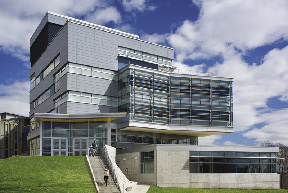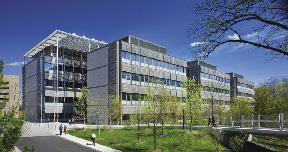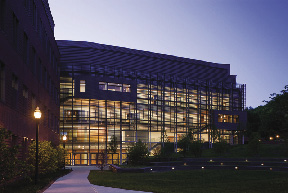Three of Payette's projects have been recognized in the 2011 Design Awards program sponsored by the Boston Society of Architects (BSA). The Frick Chemistry Building at Princeton was honored with an Honor Award for Design Excellence, while the Carl J. Shapiro Science Center at Brandeis University and the University of Massachusetts Integrated Science Building were selected within the Higher Education Facility Design category.
BSA DESIGN AWARDS: Honor Award for Design Excellence
The Honor Awards program is open to any architect or designer from Massachusetts, or from anywhere in the world with a project built in Massachusetts. The BSA has a reputation for being one of the finest AIA chapters in the country, and the awards program is a commitment towards increasing the quality of architecture within the commonwealth. This year, 121 projects were submitted and 16 awards were presented.
Each year the BSA, often in collaboration with other organizations, sponsors awards programs to honor design excellence in Massachusetts, throughout New England and elsewhere. Design awards celebrate the ways in which architects and building-industry professionals contribute to their communities. Smarter spaces have the potential to elevate the quality of life for their users while contributing to a more sustainable world.
Honor Award: Princeton University, Frick Chemistry Laboratory
Princeton, N.J.
Princeton's new Frick Chemistry Laboratory moves the entire Department of Chemistry at Princeton from the nation's oldest chemistry laboratory to a new state-of-the-science facility. The result of a collaborative design effort between Payette and Hopkins Architects of London, the new structure is equipped with both cutting-edge and sustainable amenities and fully integrates Princeton's teaching and research programs. The building is organized around a central light filled atrium, with research labs on the east side connected by pedestrian bridges office, conference and break-out spaces on the west. As has been the case for much of Payette's previous work at Princeton over the past 30 years, the firm's goal is for the Frick Chemistry Laboratory is to set a new standard for chemistry research and education in the country. Its unique organization of space and careful use of advanced engineering are highly sympathetic to sustainability and operating costs. It also exhibits Payette's continued commitment to create buildings that support intellectual and social interaction.
The jury remarked: "Tightly organized and carefully resolved, there is not a gesture out of place in this disarmingly simple yet complex building. It has a well-conceived conceptual diagram and plan, ordering the uses of the building in a logical manner. Many of the spaces in the building are welcoming and friendly, which are unusual attributes in a high-performance environment. The curtainwall details are very sophisticated, both inside and outside. The use of interior wood and color are well handled, giving the building a lively, engaging presence. We liked the scale of the building in its academic setting."
The project team included Payette as Architect in collaboration with Hopkins Architects, design architect; Turner Construction Co.; Arup, Harvey Associates; and Michael Van Valkenburgh Associates.
BSA DESIGN AWARDS: HIGHER-EDUCATION FACILITY DESIGN
The Boston Society of Architects (BSA) Education Facilities Design Awards recognizes any education facility built anywhere in the world designed by a New England or New York architect/firm, or any education facility built in New England or New York by any architect/firm anywhere in the world. The sole judging criterion is design excellence. The jury is empowered to determine the extent to which design excellence is defined by aesthetic, functional, contextual, sustainable, social or other characteristics. This year, the awards jury gravitated toward simple, uncluttered forms that they could grasp at a glance. They applauded clarity of idea and restraint, appreciating how much skill is required to create a human scale within the context of large projects. From 59 submissions in this category this year, six projects were selected.
Award: Integrated Science Building, University of Massachusetts at Amherst
Amherst, Mass.
The Integrated Science Building at the University of Massachusetts at Amherst facility is intended to foster interaction and collaboration between students and research faculty in various areas of scientific study. The project is located in the heart of the campus close to the existing biology and chemistry facilities. Major programs located in the facility include introductory level chemistry teaching laboratories, upper level chemistry and biology teaching laboratories, and research faculty laboratories. Payette planned the development of a second phase that will incorporate upper level molecular biology and biochemistry laboratories as well as additional research laboratories creating a science center for the campus.
Commented the jury: "Restrained and well oriented, facing south, this newly constructed science center is thoughtful and well planned. Within the campus context, it is a great "team" player, with a handsome screen wall comprising horizontal louvers that moderate daylight. Walkways connecting the building to the rest of the campus are inviting. More than a collection of timely, iconic features, the project comes together beautifully and suggests a strong, clear plan. The interior architecture holds up well, and the window proportion relates very well to the surrounding campus."
The project team included Payette, Gilbane, R. G. Vanderweil Engineers, Lim Consultants, and Nitsch Engineering.
Citation for Design: Carl J. Shapiro Science Center, Brandeis University
Waltham, Mass.
The new Carl J. Shapiro Science Center represents the keynote project in an ambitious expansion and renewal of the sciences at Brandies University. Phased new construction generated 150,000 s/f of new research, teaching and instrumentation space. The building functions as a catalyst for scientific innovation, interdisciplinary discourse and a renewed vibrancy of student and faculty activity. Envisioned as a sophisticated and expressive modern building it houses a multi-story atrium of interconnected bridges and open staircases creating a new "hub" of connectivity. The preceding Payette Science Center Master Plan outlined a phased approach to the evolution of the complex as a vital campus center of interdisciplinary scientific discourse, enhanced infrastructure to support modern scientific research, and opportunities to advance the value of science to the broader community.
The jury said: "Part renovation, part new construction, this project's interiors are universally inviting, making excellent use of color and scale. We appreciated the designer's careful planning, with its clarity of expressed ideas."
The project team included Payette, John Moriarty & Associates, Buro Happold, Simpson Gumpertz and Heger, Nitsch Engineering, and Landworks Studio.
.png)









